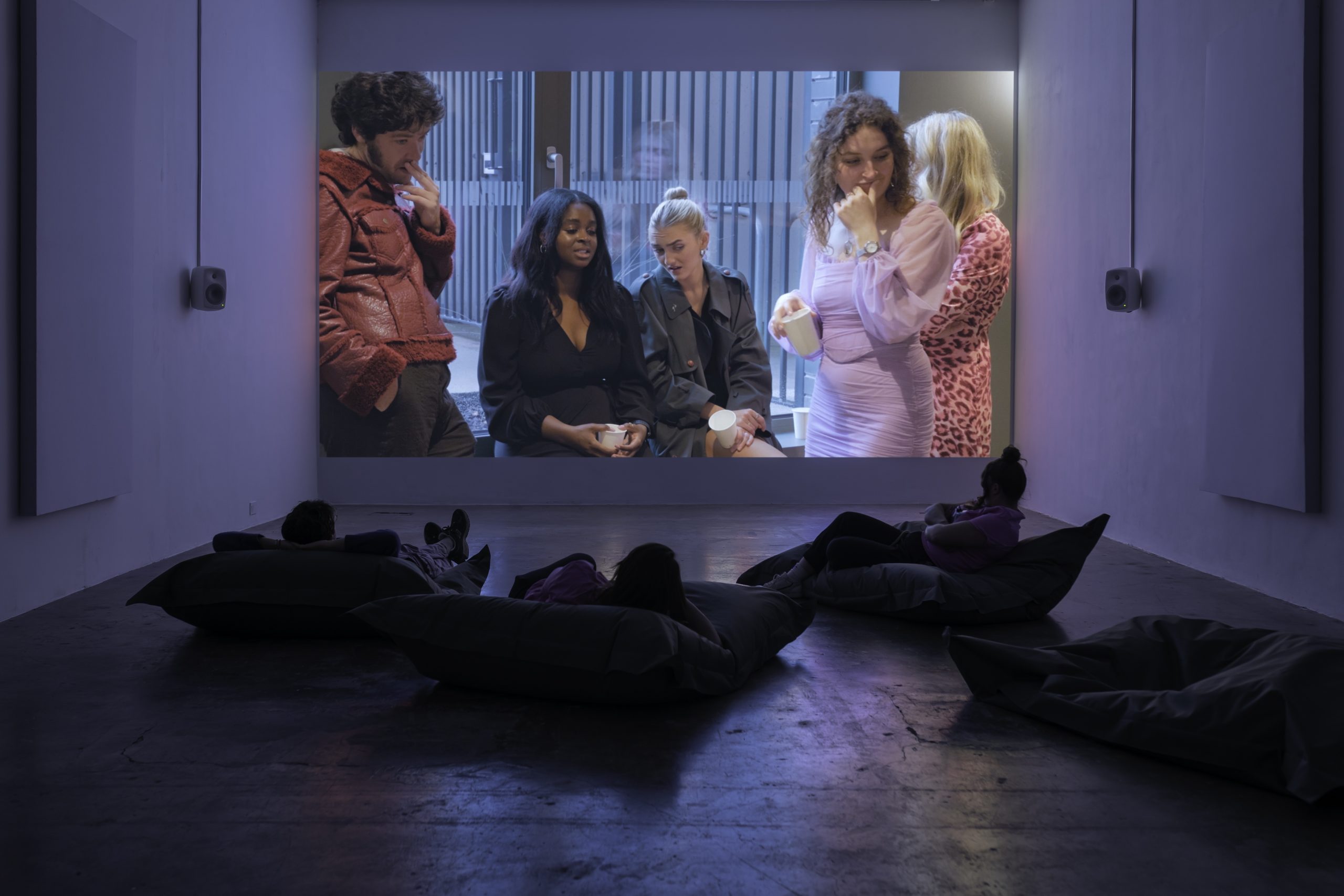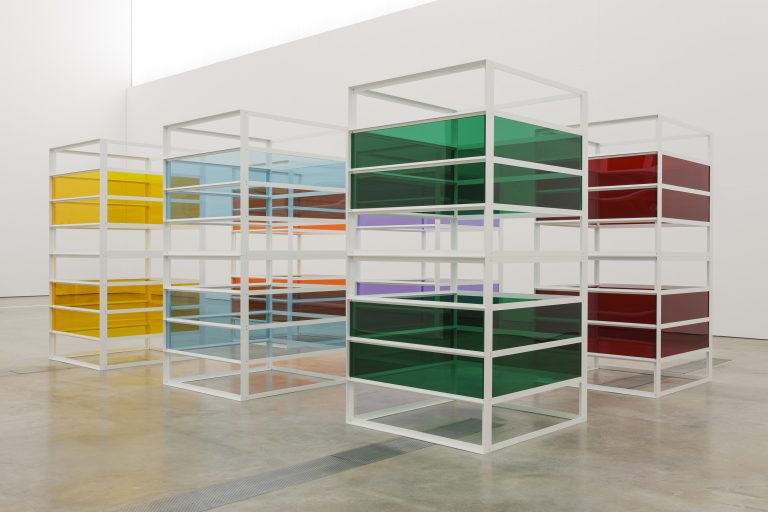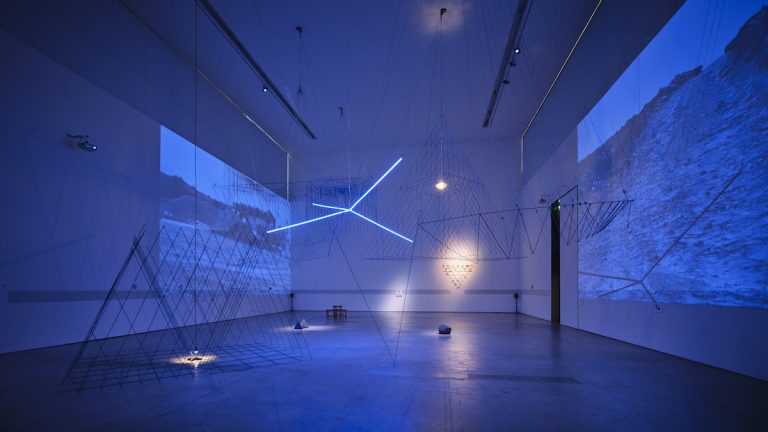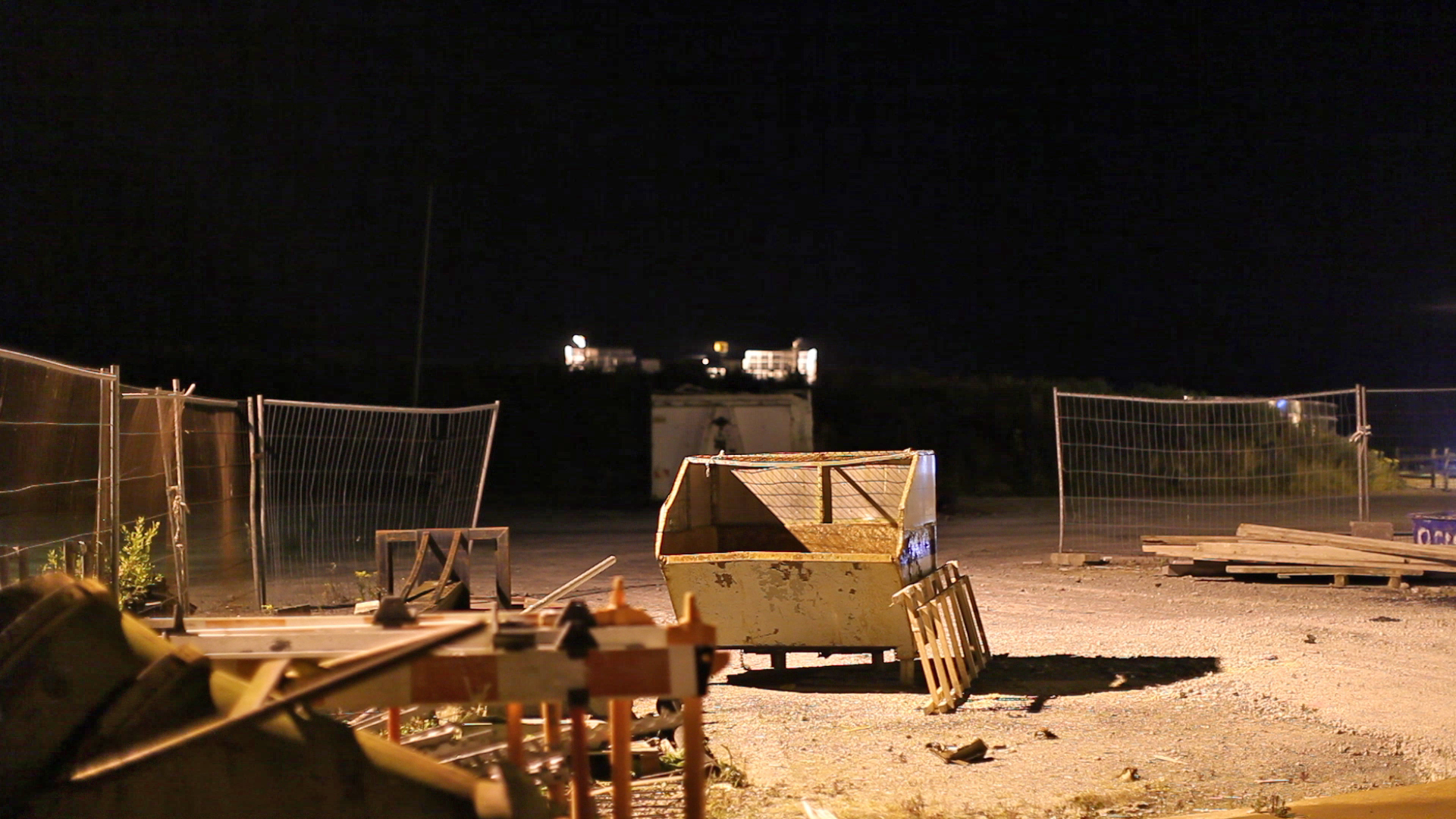For Eva Richardson McCrea’s exhibition at Project Arts Centre, a false wall creates an entry corridor that also houses a monitor showing a CCTV recording of the sleeping artist. An exhibition note tells us that she lived on location in an anonymous ‘co-living’ complex, while surreptitiously staging and filming events there. The grainy CCTV footage implicates her directly into the process – she, too, has been filmed – and it’s tempting to think of the main drama, however collaborative, as the outcome of her dreaming. Projected onto the gallery wall, this sixty-six-minute video also has a corridor sequence, reappearing as a linking device between different episodes. Shot on a shaky, hand-held camera and stylistically at odds with the rest of the film, these moments feel Kubrickian, as though drawn from the aptly named, and distinctly unheimlich, ‘Overlook Hotel’.
Richardson McCrea’s The Decameron / Na Deich Lá (2025) is the most recent in a series of major projects commissioned or co-commissioned by curator Sara Greavu and Project Arts Centre dealing with the question of housing. Avril Corroon’s GOT DAMP / PÚSCADH ANUAS was presented at the gallery in 2023, while Eimear Walshe’s Romantic Ireland was the official Irish representation at the 60th Venice Biennale in 2024. GOT DAMP, and an earlier work by Richardson McCrea called Rope (2022), were both shown as part of Living Conditions, a programme of screenings and events concerned with ‘the systemic crisis embedded into the architecture of our everyday’, curated by Niamh Darling, and held at the Douglas Hyde Gallery in February 2025. [1] At the time of writing, the LAB Gallery is hosting Liquid Urbanisms, an exhibition curated by Clara McSweeney that focuses on ‘the speculative futures of buildings and dwellings in Ireland in the context of the ongoing housing crisis.’ [2] Through these and other initiatives, a significant body of work by Irish artists dealing with issues of housing and the built environment has gradually emerged.

Eva Richardson McCrea, Sleep, installation view, Project Arts Centre, 2025. Single-channel SD video, silent, 05:23:50. Photo: Louis Haugh. Courtesy the artist and Project Arts Centre.
Within the confined living spaces of Richardson McCrea’s mise-en-scène, tensions between the agency of her ten characters and the invisible hand of systemic forces are gradually exposed. If the economic tides turning accommodation into capital are the ulterior powers presented here, they seem to have infiltrated the troubled mind-sets of the characters themselves. The opening scene presents the first in a sequence of neatly bland interiors, a brightly lit room replete with book shelves and musical instruments. Absent of mess, or any sense of real life, we might be in a newly built apart-hotel or some kind of show house. In the gallery, a row of beanbags seems designed to situate viewers closer to the film’s protagonists; invited to be comfortable within a public space, but like them, not quite at home. Though the film is long – a digital countdown precedes each precisely timed screening – I remained sitting upright.
A young woman is distracted from her reading by a young man awkwardly hanging out by the bongos. ‘Do you play anything?,’ she asks. The man shrugs, ‘I took a few lessons once, but decided to quit.’ ‘They say you’re less likely to get dementia if you play a musical instrument,’ she tells him. This exchange typifies the air of suspension throughout, of stilted conversations seemingly devoid of context or real consequence. Later on, another young woman exclaims, ‘It’s like I had to go through a series of ego deaths to get here.’ The different characters, like us, are still trying to figure out who they are. They are awkward and self-conscious in their efforts to connect, and we get to know them as they try to get to know each other, a synchronicity that helps maintain our attention. In Boccaccio’s The Decameron, his fourteenth-century characters are quarantined together in an effort to escape the Black Death. [3] The young protagonists here are also trapped by a contagion, but one implied rather than named, and more economic than biological.
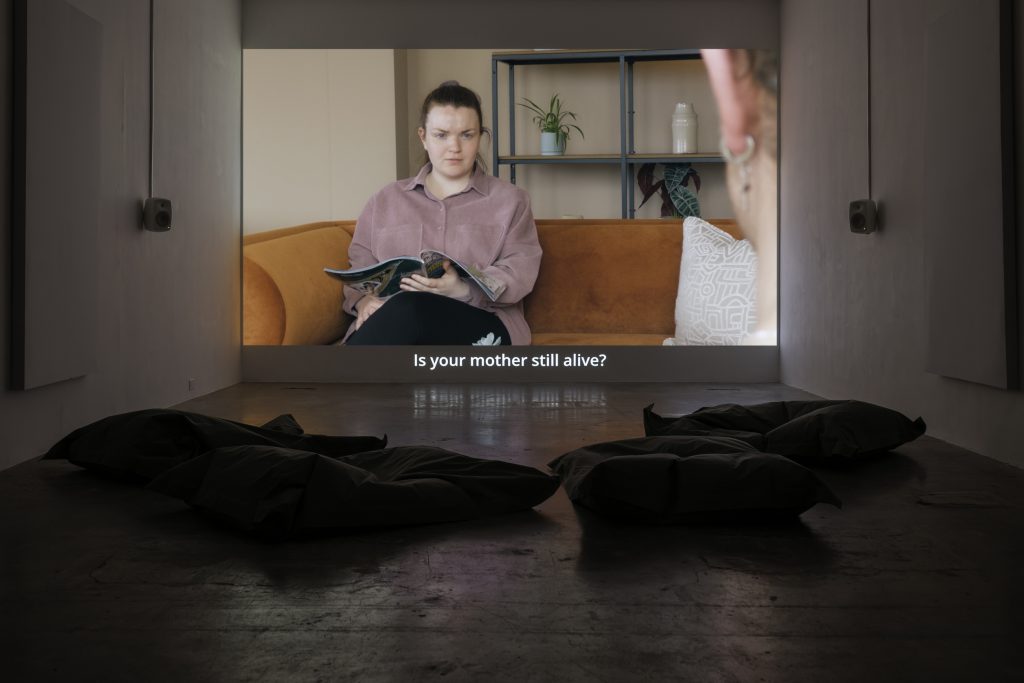
Eva Richardson McCrea, The Decameron/Na Deich Lá, installation view, Project Arts Centre, 2025. Single-channel 4K video, sound, 01:06:34. Photo: Louis Haugh. Courtesy the artist and Project Arts Centre.
While audible through wall-mounted speakers, conversations are also conveyed through subtitles. And not only conversations. A close-up of someone’s dinner is accompanied by the words ‘sucking sound of congealed pasta’. While it’s not entirely clear what this doubling represents, artifice, broadly speaking, is highlighted in other ways, including exaggerated facial expressions, laboured dialogue and a self-conscious nodding to artistic precedents. The filming was done on iPhones, surreptitiously, we’re told, but the different setups, cast of characters, and effective sound recording all suggest complex logistics. Within this ambiguous arrangement, the similarly aged characters – one such describes herself as ‘halfway to fifty’ – are not the cyphers we might first expect, but pleasingly varied and idiosyncratic.
We’re also told that scenes were developed through Character-Based Improvisation workshops, a method encouraging actors to weave their personal experience into the characters they play. The actor shows their subject, to paraphrase Bertolt Brecht, while also showing themselves. [4] In their self-conscious interactions (and the occasional breaking of the fourth wall), we are continuously reminded of the constructed nature of events. Brecht, and the practice of so-called epic theatre, seems to underpin much of the artist’s work. Epic theatre replaces the catharsis of classical theatre with self-reflection. The task of drama is not absorption, but the accurate representation of social conditions, with writers, producers, and performers all collaborating towards this end. Stagey, dialogue-driven, and often formed around preexisting or collaborative texts, Richardson McCrea’s previous works like Rope (2022) and Table Games (2021) feel didactic more than dramatic, in keeping with their historical influences. But here, while the film is carefully structured with distancing devices and other tropes, my learning experience felt coincident with the unfolding drama and subsequently more entertaining. This could be a cardinal error, or a godsend, depending on your politics.
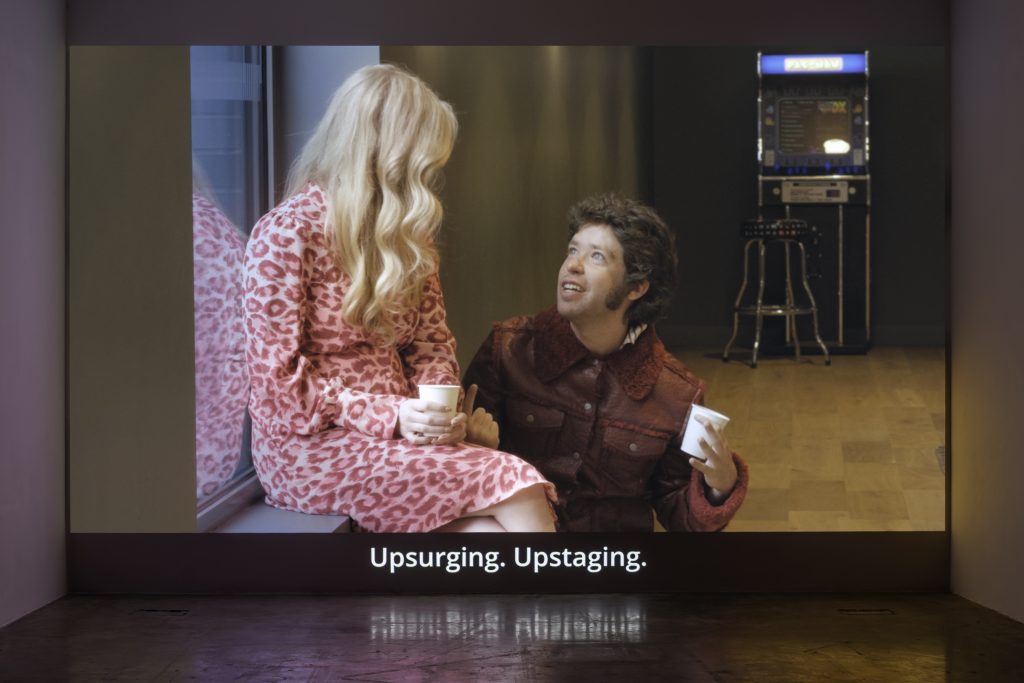
Eva Richardson McCrea, The Decameron/Na Deich Lá, installation view, Project Arts Centre, 2025. Single-channel 4K video, sound, 01:06:34. Photo: Louis Haugh. Courtesy the artist and Project Arts Centre.
The acting in The Decameron / Na Deich Lá feels provisional, but this is well suited to the characters’ provisional circumstances (and among all the back and forth, no one is asked where they come from). As well as theatre, filmic influences are also in evidence – the meandering interactions of Michelangelo Antonioni, the absurd entrapments of Luis Buñuel – but also the more formulaic absurdities of reality TV. In semi-staged dialogues typical of this medium, topics as diverse as country music, Don Quixote, and toxic potatoes all feature (but no dating. No one in this cauldron of stylistic tropes seems interested in sex). [5] Describing a night of restless sleep, a moustachioed young man recalls dreaming of being chauffeured by his mother. ‘Do you want your mother to pick you up from where in life you are now?,’ his archly sympathetic friend asks, as though parodying some psychoanalytic exchange. Despite the artifice, I found myself caring about these quirky characters. A woman enjoys tormenting her housemates with mildly sinister suggestions (those toxic potatoes), while another smiles wryly at every remark as though storing up ammunition for later use. A pensive young man seems lovelorn, but we’re not sure over whom, while another appears feckless, thinking only of when the much talked about party might begin. I had a real soft spot for the restless sleeper, an earnest young man on the edge of breakthrough or disaster. The self-scrutinising blonde, who spoke earlier about her ‘series of ego deaths’, reminds herself, and anyone else who’ll listen: ‘In the galaxy of my life, I am the brightest star.’
Like denizens of a late twentieth-century waiting room, several characters appear flipping through magazines. These anachronistic moments – quizzes and boardgames also have this effect – serve to emphasise a prevailing uncertainty. While seemingly at home, for the protagonists it’s a space of brief encounters, culminating in a celebration to which everyone is invited. ‘All right, party people,’ the restless sleeper, and now temporary DJ, proclaims, ‘Let’s celebrate life, every day, everywhere!’, and for a while at least, the collective mood brightens. Before long, though, and overlapping with the revelry, characters begin falling back into modes of introspection. A reserved young woman, perhaps unused to alcohol, provides the film’s visceral coda. Helpfully cleaning up after her, a housemate marvels at the ‘pretty big splash zone’, a kindly reaction to what might otherwise have been embarrassing. Immediately prior to this messy finale, a group sing-along repeats the words of John Denver’s famous paean to lost horizons, ‘Country Roads, take me home, to the place I belong.’ Both touching and deeply ironic, this temporary ensemble, united for now, are going nowhere.
John Graham is an artist and writer based in Dublin.
Notes
[1] From https://thedouglashyde.ie/event/living-conditions/
[2] From https://www.dublincityartsoffice.ie/programmes-projects/lab-gallery/liquid-urbanims
[3] The Decameron is a collection of short stories by the fourteenth-century Italian author Giovanni Boccaccio. The book is structured as a frame story containing one hundred tales told by a group of seven young women and three young men as they shelter in a secluded villa outside of Florence in order to escape the Black Death.
[4] Walter Benjamin, What Is Epic Theatre? (1970), collected in Illuminations (London: Pimlico Random House, 1999), 150. First published Mass und Vert in 1939.
[5] The work of Eimear Walshe, by contrast, is more concerned with the conjunction of property status and the libidinous, as their 2021 video lecture The Land Question: Where the fuck am I supposed to have sex? lays out. The film is available here: https://criticismism.com/eimear-walshe-the-land-question-where-the-fuck-am-i-supposed-to-have-sex-2021/

